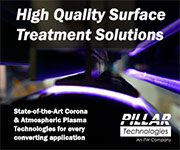Getting the most value from your extrusion coater.
- Published: December 01, 1996, By Simonsis, Yolanda
Quantum Chemical Corp. assists converters with product and process improvements on its state-of-the-art extrusion coating line located at the Allen Research Center.
Many extrusion coaters are faced with the challenge of increasing their output, improving adhesion to substrates, and developing new extrusion coated structures. Determining optimum operating conditions often requires normal production to be halted in order to conduct experimental runs. Quantum Chemical Corp.'s Allen Research Center in Cincinnati, OH, has saved many of Quantum's customers from the hassles of interrupted production time.
The Quantum line has extensive extrusion coating capabilities and, over the years, its operators and engineers have accrued a great deal of knowledge during their research and development efforts. They are willing to share that knowledge with existing and prospective customers.
A key to most R&D efforts or production trials, particularly if frequent short runs are involved, is flexibility. As a major supplier of polyolefin extrusion coating resins, tie-layer resins, and color concentrates, Quantum runs an extrusion coating line with a wide range of capabilities. During its operation, the line has been updated and retrofitted with the most advanced technology available from leading industry suppliers. Even a converter with older equipment can keep pace with the state of the art, if management is willing to invest in current, retrofittable equipment.
Integrated Process Control
At the virtual core of Quantum's extrusion coating line, helping to maintain that crucial flexibility, is a Eurotherm integrated process controller PC3000 that's configured with a Microcell software package. The PC3000/Microcell combination provides the functionality of a programmable logic controller (PLC) and a process control system with a built-in operator interface.
The PC3000 controls the extruder and die temperatures, monitors melt pressures, and provides an interface to the drive system. Precise temperature control of the barrel and die zones is achieved by the use of heat/cool PID auto-tune function blocks. A communication port on the PC3000 provides a link for the transfer of data between the operator and the drive system.
The Microcell software is used to configure the PC3000 and also has built-in, run-time capabilities. The configurator supports a wide variety of editors, including sequential function charts (SFC), structured text (ST), spreadsheet (SS), and graphical function block (FB). The integrated database run-time feature of Microcell allows the operator to make real-time changes to temperature or drive setpoints or to download and run a customized recipe. Microcell also has an alarm manager to alert the operator to the status of critical parameters in the system.
Quantum's research specialist R.F. Knor explains, "Real-time data logging and trending provide the operator with a window into the process. Data can be gathered, logged, trended, and reviewed. Every detail is automatically recorded, there is no need for taking notes, and there is no possibility for forgetting to record information. And all the data can be exported for evaluation."
Another very useful feature is the ability to log data and generate custom reports. This allows the operator to attend to other duties instead of having to manually record information.
The drive system uses 11 Eurotherm Model 590 DC drive controllers linked by a fiber optic network that replaced traditional hard wiring. Thread, jog, line speed, and tension parameters are all coordinated over this high-speed network. It is this feature, which is part of the Eurotherm package, that affords real-time control abilities on the line. Knor adds, "Process errors are quickly detected and automatically changed with virtually no loss of product and without having to shut down the line. The operator simply touches the control center screen to increase or decrease a specific option."
Ozone Generator Adds Benefits
Part of updating the lab line was the addition of an ozone generation unit. Quantum uses the ozone generator in its own experiments to test the adhesion benefits derived from ozone application at the nip roll in the extrusion coating process. This on-going adhesion enhancement research is done in conjunction with Enercon Industries, who supplied an Ozonator[TM] ozone generator for Quantum's line. Using the Ozonator in conjunction with two "H" system pre- and post-treat corona treaters from Enercon, Quantum reports that it has significantly improved bond rates and increased productivity while supplying customers with treated substrates for subsequent converting processes.
In addition to increasing bond strength, the addition of ozone at the extruder has contributed to increasing overall line speeds, resulting in more product with stronger bonds.
Quantum has also determined that ozone treatment has permitted lower melt temperatures for the extrudate. This is especially important for materials that can char easily. The reduced temperatures also help the chill rolls to operate more efficiently. While this melt temperature reduction may be only a few degrees, even a small reduction has positive results, such as reduced odor, in the finished product.
Using ozone to boost bonds has an additional benefit, because it allows the substrate converter, in some cases, to eliminate chemical primers.
Consistency and Repeatability
Quantum has found that consistency and repeatability are mandatory features for any process, whether on an R&D lab/pilot line or on a converter's production line. Customers, in Quantum's case, are able to view detailed reports of the complete line's operating setup as their trial is being run. And, they are able to make necessary adjustments and changes almost instantly. If a customer determines that further adjustments are necessary after the trial has ended, Quantum is able to produce the same product with the new changes almost instantly. A computer-based logging and custom report capability allows Quantum to provide a complete record of all trials for its customer.
The extrusion coating line at Quantum includes two extruders from Black Clawson and one from Beloit. The extrusion coating die is from Jyohoku (represented by Black Clawson in the US), the gauging system is from NDC, and all drives and controls are from Eurotherm. In addition to the corona treaters and ozone generator from Enercon, the line features a flame treater from Wise for adhesion enhancement.
Capabilities of the line include run speeds to 3,000 fpm; coextrusion from up to three different extruders to manufacture up to five layers; extrusion lamination of two flexible webs; and the ability to handle virtually any flexible substrate.
For Quantum, the ability to maintain customer records as part of a computer database has allowed the converter to make improvements even after several years have passed. Features such as that keep customers coming back again and again.
Supplier Information:
Eurotherm Controls, Reston, VA; ph: 703/471-4870; fax: 703/787-3436.
Eurotherm Drives, Reston, VA; ph: 703/471-4565; fax: 703/471-0723.
Enercon Industries Corp., Menomonee Falls. WI; ph: 414/255-6070; fax: 414/255-7784.
Black Clawson Converting Machinery Corp., Fulton, NY; ph: 315/598-7121; fax: 315/593-0396.
Jyohoku Seikosyo Co. (represented by Black Clawson in the US), Nishikata, Koshigaya-shi, Saitama 343, Japan; ph: +81(0)489-89-6317; fax: +81(0)489-89-6306.
NDC Systems, Irvwindale, CA; ph: 818/960-3300; fax: 818/939-3870.
Wise Corp., Indianapolis, IN; ph: 317/636-4488; fax: 317/636-4489.













